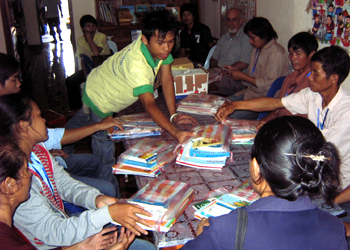

The Joy of Reading
|
For the Village Reading Room program, we begin by looking for the right person. We talk with the village headman and other leaders to select one individual to make books available in that village. We begin by providing that individual with 60 varied books, for all ages, along with suggestions about how to make them available. 
The volunteer allows other villagers to read these books, either at the volunteer's home (typically there is an outside or semi-public area available), or to borrow them. We provide a notebook to record checkouts. A steady stream of new books is crucial to the success of any reading room or library, so we deliberately began with only a portion of what we had available. Several times a year we provided new titles. Results: We continued setting up more, and by the end of 2011 we had 180 reading rooms. It takes time for an awareness and appreciation of books to spread. We helped, by holding workshops where we promoted reading aloud and other techniques to encourge reading. Often, several of our staff go to a village for a period of 2 to 5 days, to build shelves and generate interest. Evaluations showed gradual but steady increases in reading. Many reading rooms had 30 to 100 books borrowed in a single month. By the end of 2011, we also saw a genuine change in attitudes, in the villages where we'd done the most work. A significant number of people were enthused about reading. Children and families took books along, when they went to the fields to work, so they could read when they rested. However, activity remained dependent on our visits; we found that without three contacts a year (in which we visited a village, or they came to a workshop in their district), interest tapered off in most villages. As the number of reading rooms grew, maintaining that level of support grew harder. During this period we developed the daily reading program in schools, which so far has shown a greater impact with fewer visits. In 2013-2015, we've put our focus on the school reading program. Where the village reading rooms have continued to function well, usually because of one dedicated individual, we continue to provide support and new books. In the future, as the school program creates more interest in reading, and more books are available from us and other publishers, it seems likely that village reading rooms can more readily become self-sustaining without continued visits from us. |